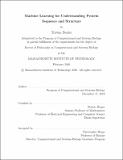Machine learning for understanding protein sequence and structure
Author(s)
Bepler, Tristan(Tristan Wendland)
Download1237266130-MIT.pdf (22.13Mb)
Other Contributors
Massachusetts Institute of Technology. Computational and Systems Biology Program.
Advisor
Bonnie Berger.
Terms of use
Metadata
Show full item recordAbstract
Proteins are the fundamental building blocks of life, carrying out a vast array of functions at the molecular level. Understanding these molecular machines has been a core problem in biology for decades. Recent advances in cryo-electron microscopy (cryoEM) has enabled high resolution experimental measurement of proteins in their native states. However, this technology remains expensive and low throughput. At the same time, ever growing protein databases offer new opportunities for understanding the diversity of natural proteins and for linking sequence to structure and function. This thesis introduces a variety of machine learning methods for accelerating protein structure determination by cryoEM and for learning from large protein databases. We first consider the problem of protein identification in the large images collected in cryoEM. We propose a positive-unlabeled learning framework that enables high accuracy particle detection with few labeled data points, both improving data quality and analysis speed. Next, we develop a deep denoising model for cryo-electron micrographs. By learning the denoising model from large amounts of real cryoEM data, we are able to capture the noise generation process and accurately denoise micrographs, improving the ability of experamentalists to examine and interpret their data. We then introduce a neural network model for understanding continuous variability in proteins in cryoEM data by explicitly disentangling variation of interest (structure) for nuisance variation due to rotation and translation. Finally, we move beyond cryoEM and propose a method for learning vector embeddings of proteins using information from structure and sequence. Many of the machine learning methods developed here are general purpose and can be applied to other data domains.
Description
Thesis: Ph. D., Massachusetts Institute of Technology, Computational and Systems Biology Program, February, 2020 Cataloged from student-submitted PDF of thesis. Includes bibliographical references (pages 183-200).
Date issued
2020Department
Massachusetts Institute of Technology. Computational and Systems Biology ProgramPublisher
Massachusetts Institute of Technology
Keywords
Computational and Systems Biology Program.